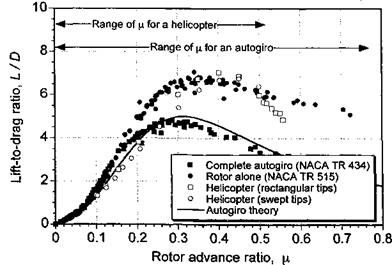NACA Research on Autogiros
While the RAE in Britain had conducted experiments with autogiros, and had developed a theoretical basis for their analysis as early as 1926, it was not until the early 1930s that the extensive resources of the NACA were turned toward the science of rotating wings. Over the next ten or more years, the autogiro was to be tested extensively, with the work forming a solid foundation for later work on helicopters. In 1931, the NACA purchased a PCA-2 autogiro and this aircraft became the basis for extensive night and wind tunnel testing (see Fig. 12.13) for almost 8 years, until the helicopter appeared. Gustafson
(197І) gives a first hand summary of the early NACA technical work on both autogiros and helicopters, and Gessow (1948) gives a complete technical bibliography.
The first published NACA report on the autogiro was by Wheatley (1933a), which provided an authoritative baseline measurements on the performance of the PCA-2 autogiro. Measurements of rates of descents and glide angles were obtained (see Fig. 12.2), along with estimates of rotor lift-to-drag ratio. Separate tests of the rotor were also conducted in the wind-tunnel [see Fig. 12.13 and Wheatley (1934)] allowing quantification of the rotor
 |
performance alone compared to the complete PCA-2 aircraft. As shown in Fig. 12.14, the aerodynamic efficiency of the autogiro was relatively poor compared to most airplanes, with a maximum L/D ratio of only about 4.5. The differences between the rotor alone and the complete aircraft reflects the high parasitic drag of the airframe. However, to put the results in perspective, the performance of the rotor alone, which had a maximum L/D ratio of about 7, is comparable to that of a modem helicopter rotor. Notice that for higher advance ratios (or tip speed ratio) the helicopter rotor L/D ratio drops off markedly, in part because of retreating blade stall and advancing blade compressibility effects, whereas because the
|
Figure 12.14 Lift-to-drag ratio in autorotation for complete autogiro (PCA-2) versus the rotor alone. The lift-to-drag ratio of a rotor in autorotation is comparable to that of a modem helicopter rotor. Data source: Wheatley (1933a) and Wheatley & Hood (1934). |
autogiro rotor has a relatively low rpm and low disk loading it retains its L/D ratio to as high as /л = 0.7 (although not necessarily to a higher airspeed).
Wheatley (1933b) studied the load sharing between the rotor and the wing and also examined the maneuver characteristics of the autogiro. One of the most remarkable findings in this work was a sustained maximum maneuver load factor of 4.3, which is high for any kind of rotorcraft and rarely obtained even on modern combat helicopters during transient maneuvers – see Section 5.9. The main reason for this large value was the relatively low blade loading and low mean lift coefficients of the autogiro rotor, which lead to good stall margins. The role of the wing was also important in off-loading the rotor at higher airspeeds and during maneuvers. Flight tests with the PCA-2 demonstrated forward speeds of 140 mph, with an advance ratio in excess of p = 0.70. This is a very high advance ratio for a rotor, but is possible on an autogiro if the rotor is offloaded by a wing.
The earliest theoretical studies of the autogiro at NACA resulted in one of the first thorough aerodynamic analyses of the rotor – see Wheatley (1934b) & Bioletti (1935). Later, a now classic report by Bailey (1941) extended the earlier work of Glauert (1926, 1928) and Lock (1928) and included the treatment of blade twist, reverse flow, nonuniform inflow, and tip-loss effects on the aerodynamics of the rotor. The predictions were shown to be in good agreement with both flight and wind tunnel measurements. The NACA worked extensively on several other technical problems (both from an experimental and a theoretical perspective) that w ere to occur during the maturation process of the autogiro. This included work on rotor dynamics, vibration, airfoil sections, jump takeoffs, and ground resonance – see Gustafson (1971).












